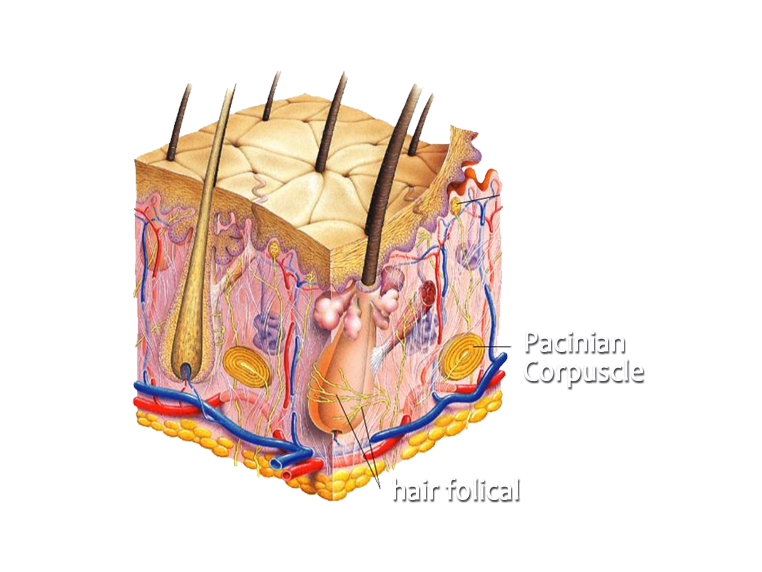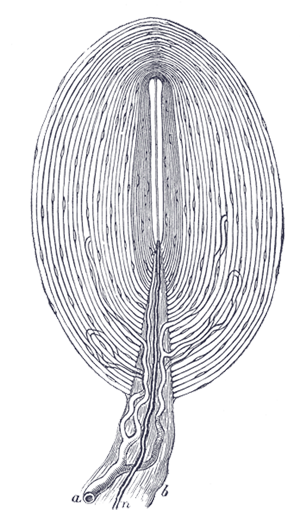
“Touch is a very powerful rewarding stimulus — just like your chocolate that you find in your cupboard at home." —Matt Hertenstein, experimental psychologist at DePauw University in Indiana.
In 1734, Johann Wilhelm Albrecht explained the effect of sound on the body as happening quite independently of the ear, though the actual physiological effect described by Albrecht was not discovered until the nineteenth century. Pacinian corpuscles, named after its discoverer, Italian anatomist Filippo Pacini (1812-1883), are mechanoreceptors located in the skin—the body’s largest organ—and are responsible for sensitivity to pressure, touch, and vibrations. Pacinian corpuscles are composed of concentric rings, kind of like an onion or a tree, and pressure from vibrations causes the rings to deform. Outer layers start to spin and sodium ion channels open, allowing an influx of sodium ions. A buildup of sodium sends signals, via nerves that connect to our central nervous system, to the nerve bundle deep in the brain called the vagus nerve. The vagus nerve branches to the lungs, heart, upper digestive tract, and other organs of the chest and abdomen; when we faint, an over-active vagus nerve has lowered our heart rate and blood pressure too much and we lose consciousness. The vagus nerve communicates with the diaphragm, so with deep breaths, a person will feel more relaxed. The vagus nerve also sends anti-inflammatory signals to parts of the body and helps manage fear, stress, and anxiety. When you know something “in your gut,” the vagus nerve is talking to you.
In my sound therapy practice, I use Acutonics tuning forks not only to stimulate acupuncture points and meridians with sound, but also to convey soothing signals to the brain wherever sound touches the skin. (Interestingly, a Pacinian corpuscle’s optimal sensitivity is 250 Hz, approximately a B in the Western musical system, the tone of the Acutonics Sun fork.) Additional “transmitters,” such as Tibetan bowls, can produce their own palliative effects. So sound therapy is also touch therapy. It is well-known that supportive touch can produce positive outcomes, and the stimulation of Pacinian corpuscles is the main player in this transformation. In addition to reducing our stress response, vibrational sound therapy may trigger the release of oxytocin (as demonstrated in touch therapy research), and oxytocin influences trust behaviors, among other things. A region of the brain called the orbital frontal cortex—the area that responds to sweet tastes and pleasant smells—activates in response to (friendly) touch; thus, touch is a powerful rewarding stimulus, “just like your chocolate that you find in your cupboard at home."
The tiny Pacinian corpuscle, and its function in interpreting vibration, points to the mystery and profundity of sound as a therapeutic tool. My hope is that more and more researchers will acknowledge these connections between vibrations and the functioning of the body and be inspired to study the effects initiated by the touch of a simple sound wave.
In 1734, Johann Wilhelm Albrecht explained the effect of sound on the body as happening quite independently of the ear, though the actual physiological effect described by Albrecht was not discovered until the nineteenth century. Pacinian corpuscles, named after its discoverer, Italian anatomist Filippo Pacini (1812-1883), are mechanoreceptors located in the skin—the body’s largest organ—and are responsible for sensitivity to pressure, touch, and vibrations. Pacinian corpuscles are composed of concentric rings, kind of like an onion or a tree, and pressure from vibrations causes the rings to deform. Outer layers start to spin and sodium ion channels open, allowing an influx of sodium ions. A buildup of sodium sends signals, via nerves that connect to our central nervous system, to the nerve bundle deep in the brain called the vagus nerve. The vagus nerve branches to the lungs, heart, upper digestive tract, and other organs of the chest and abdomen; when we faint, an over-active vagus nerve has lowered our heart rate and blood pressure too much and we lose consciousness. The vagus nerve communicates with the diaphragm, so with deep breaths, a person will feel more relaxed. The vagus nerve also sends anti-inflammatory signals to parts of the body and helps manage fear, stress, and anxiety. When you know something “in your gut,” the vagus nerve is talking to you.
In my sound therapy practice, I use Acutonics tuning forks not only to stimulate acupuncture points and meridians with sound, but also to convey soothing signals to the brain wherever sound touches the skin. (Interestingly, a Pacinian corpuscle’s optimal sensitivity is 250 Hz, approximately a B in the Western musical system, the tone of the Acutonics Sun fork.) Additional “transmitters,” such as Tibetan bowls, can produce their own palliative effects. So sound therapy is also touch therapy. It is well-known that supportive touch can produce positive outcomes, and the stimulation of Pacinian corpuscles is the main player in this transformation. In addition to reducing our stress response, vibrational sound therapy may trigger the release of oxytocin (as demonstrated in touch therapy research), and oxytocin influences trust behaviors, among other things. A region of the brain called the orbital frontal cortex—the area that responds to sweet tastes and pleasant smells—activates in response to (friendly) touch; thus, touch is a powerful rewarding stimulus, “just like your chocolate that you find in your cupboard at home."
The tiny Pacinian corpuscle, and its function in interpreting vibration, points to the mystery and profundity of sound as a therapeutic tool. My hope is that more and more researchers will acknowledge these connections between vibrations and the functioning of the body and be inspired to study the effects initiated by the touch of a simple sound wave.

 RSS Feed
RSS Feed